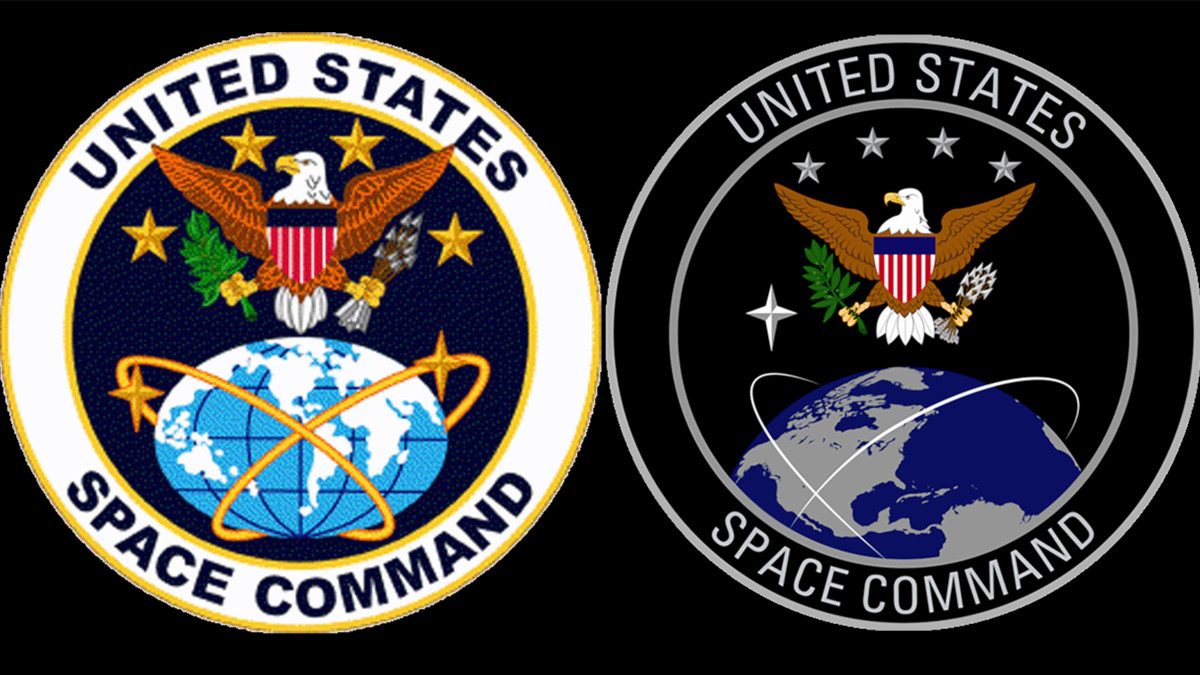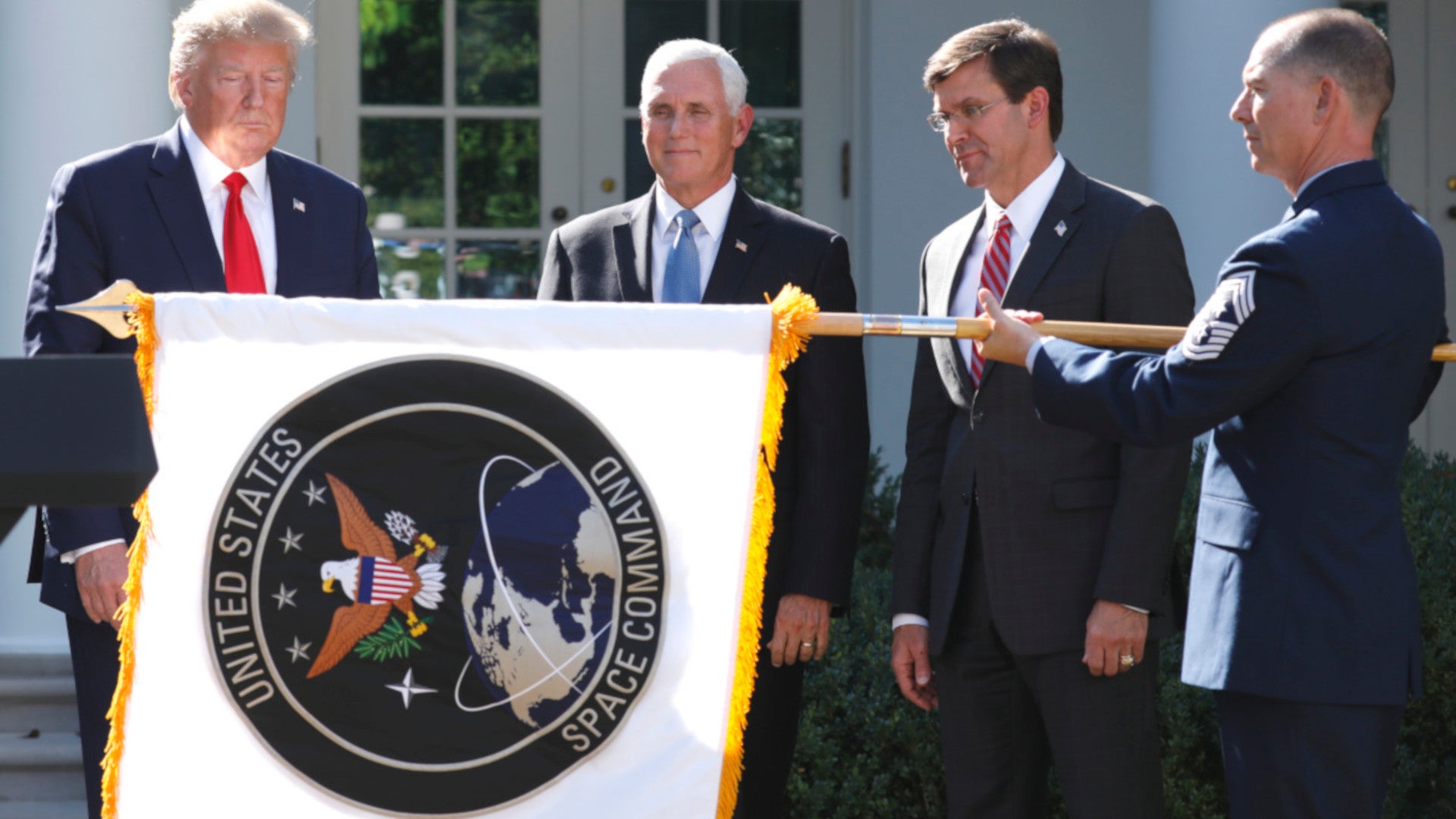For the first time in nearly two decades, the U.S. military again has a dedicated U.S. Space Command to oversee activities in this increasingly critical domain. With the large amount of hype surrounding its re-establishment, many may not realize that the United States previously had a Space Command between 1985 and 2002. This latest iteration even comes along with an insignia that takes virtually all of its cues from the logo for the previous incarnation of the command, but in a more modern, slicker-looking package.
U.S. Air Force Chief Master Sergeant Roger Toberman, together with General John Raymond, who is now head of Space Command, unfurled the revised colors during a ceremony in the Rose Garden at the White House on Aug. 29, 2019. President Donald Trump and Vice President Mike Pence, both of whom have been outspoken advocates for the creation of Space Command, as well as the possible establishment of an entirely new branch of the military, were also present, as was Secretary of Defense Mark Esper.
“This is a landmark day, one that recognizes the centrality of space to America’s national security and defense,” Trump said in a brief speech at the event. “It’s going to be a whole different ballgame.”
“We are at a strategic inflection point. There is nothing that we do [as a joint force] that isn’t enabled by space. Zero,” General Raymond said in his own short remarks. “Our goal is to actually deter a conflict from extending into space. The best way I know how to do that is to be prepared to fight and win.”
In spite of these commends, as noted, U.S. Space Command had previously existed from 1985 until 2002, when it was folded into U.S. Strategic Command. In recent years, though, space, U.S. military activities there, and their vulnerabilities during a major conflict have become a point of increasing concern, especially as potential opponents, such as Russia and China have worked to develop various anti-satellite capabilities. These are trends and developments
The War Zone
This subsequently led to the decision to reboot Space Command, which now has the following four core missions:
- Deterring potential adversaries in space.
- Protecting U.S. military space assets from those potential adversaries.
- Overseeing the continued function of vital military space-based capabilities, including, but not limited to early warning, GPS navigation and satellite communications.
- Supporting and maintaining the forces necessary to conduct these missions.
We don’t know for sure if the official descriptions of the symbolism of the various pieces of Space Command’s new logo are the same as they were for the original insignia. However, the two designs do have virtually all of the same basic graphical elements, such as four large stars, an eagle holding an olive branch in one talon and quiver of arrows in the other, and a globe with a pair of orbital paths marked out.

Here are the official descriptions of the meanings of the various components of the previous Space Command insignia:
“The dark blue disc encircled by a white band with narrow yellow borders inscribed “United States” at top and “Space Command” at bottom in dark blue letters, provides the background and symbolizes the space environment.
“The eagle and shield, a traditional symbol of American strength and vigilance, is positioned above a light blue elliptical globe with light landmasses and dark blue grid lines to represent the expansion of this strength and vigilance into space.
“The globe, as viewed from space, symbolizes the Earth as being the origin and control point for all space vehicles and represents the area of operations of the United States Space Command.
“Encompassing the elliptical globe are two yellow orbital paths crossed diagonally, each bearing a yellow polestar detailed light tan and signifying the worldwide coverage provided in accomplishing the surveillance, navigation and communications missions.
“The gold-brown eagle, detailed in dark brown and highlighted light tan, with a white head and tail; and yellow beak, eye, and talons detailed in light tan, is grasping in his right talon a green olive branch, detailed in dark green, and in his left talon 13 arrows with white arrowheads and feathers, and light tan shafts. The eagle is flanked by an arc of four yellow stars detailed in light tan, and symbolizing the fusion of the four armed services into a unified command.”
The re-establishment of Space Command may just be the start of larger reorganizations within the U.S. military with regards to space. There has been a considerable amount of debate within the Pentagon and Congress about how best to ensure that the U.S. military is giving the appropriate amount of attention and resources to space-related issues in recent years.
The possibility of creating an entire sixth military branch, which could end up called the Space Corps or Space Force, has also emerged, but would take an act of Congress. Many legislators remain unsold on the idea. You can read more about these ongoing debates in these past War Zone stories.
It remains to be seen when, or if, a new Space Force actually comes into being. In the meantime, Space Command is back once again amid broad bipartisan support within the U.S. government and looks set to be flying its new flag for years to come.
Contact the author: joe@thedrive.com
